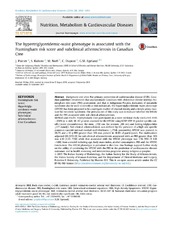The hypertriglyceridemic-waist phenotype is associated with the Framingham risk score and subclinical atherosclerosis in Canadian Cree
Peer reviewed, Journal article
Published version

Åpne
Permanent lenke
https://hdl.handle.net/1956/11637Utgivelsesdato
2015-11Metadata
Vis full innførselSamlinger
Originalversjon
https://doi.org/10.1016/j.numecd.2015.09.004Sammendrag
Background and aims: For primary prevention of cardiovascular disease (CVD), Canadian guidelines recommend that asymptomatic Canadians with abdominal obesity undergo Framingham risk score (FRS) assessment, and that in Indigenous Peoples, indicators of metabolic syndrome also be used to identify at-risk individuals. The hypertriglyceridemic-waist phenotype (HTGW) has been proposed to be a surrogate marker of visceral obesity and a simple proxy measure for metabolic syndrome. The primary aim of this study was to evaluate whether the HTGW and the FRS associated with sub-clinical atherosclerosis. Methods and results: Asymptomatic Cree participants in a cross-sectional study conducted 2005–2009 (n = 446, 18–81 y) were assessed for the HTGW using NCEP-ATP-III gender-specific-cutoffs (waist circumference: for men, ≥102 cm; for women ≥88 cm) and fasting triglycerides ≥1.7 mmol/L. Sub-clinical atherosclerosis was defined by the presence of a high sex-specific common-carotid-intimal-medial-wall-thickness (≥75th percentile). HTGW was present in 26.7% and a 10-y FRS greater than 10% was present in 18.8% of participants. The multivariate adjusted OR (95% CI) for sub-clinical atherosclerosis associated with an FRS greater than 10% was 4.10 (2.20–7.50) while that associated with the HTGW phenotype was 1.74 (95% CI 1.61–1.88) from a model including age, body mass index, alcohol consumption, FRS and the HTGW. Conclusions: The HTGW phenotype is prevalent in the Cree. Our findings support further study on the utility of combining the HTGW with the FRS in the prediction of cardiovascular disease outcomes and in health screening and intervention programs among indigenous peoples.
